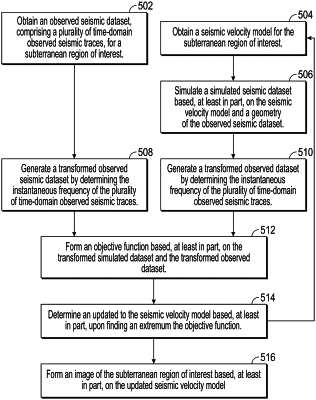| CPC G01V 1/282 (2013.01) [G01V 1/303 (2013.01); G01V 1/306 (2013.01); G01V 2210/614 (2013.01); G01V 2210/66 (2013.01); G01V 2210/675 (2013.01)] | 20 Claims |

|
1. A method of updating a seismic velocity model of a subterranean region of interest, comprising:
receiving an observed seismic dataset for the subterranean region of interest comprising a plurality of observed seismic traces;
receiving the seismic velocity model for the subterranean region of interest;
generating, using a computer processor, a simulated seismic dataset comprising a plurality of simulated seismic traces based, at least in part, on the seismic velocity model and a geometry of the observed seismic dataset;
determining, using the computer processor, a transformed observed seismic dataset, comprising:
forming a first regularized estimate of a first instantaneous frequency of at least one member of the plurality of observed seismic traces,
wherein the first regularized estimate is based, at least in part, on a first smoothing matrix, and
determining the first instantaneous frequency based, at least in part, on the first regularized estimate;
determining, using the computer processor, a transformed simulated seismic dataset, comprising:
determining a second instantaneous frequency of at least one member of the plurality of simulated seismic traces;
forming, using the computer processor, an objective function based, at least in part, on the transformed observed seismic dataset and the transformed simulated seismic dataset; and
determining, using the computer processor, an updated seismic velocity model based, at least in part, upon finding an extremum of the objective function.
|